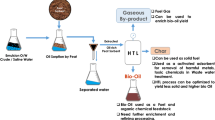Abstract
This article reports on the utilization of chemically modified cellulosic sago (MCS) from sago bark as a highly potential material for remediating oil spills in marine environment. MCS was prepared via incorporation of hydroxyl-rich cellulosic sago bark (CS) with fatty acid derivative. The sorption capacity, hydrophobicity, and lipophilicity of MCS and CS were evaluated. MCS exhibited higher total pore volume (0.012 cm3/g) and high hydrophobicity (60%) compared to CS. The oil spills adsorption studies was compared in batch system both in deionized water and seawater. MCS showed higher oil sorption capacity in deionized water after 60 min (MCS 3.0 g/g, CS 2.4 g/g). The maximum oil sorption capacity of MCS in dynamic seawater system was 5.7 g/g which was higher than CS (5.0 g/g). The results suggested that MCS is a potential low-cost natural sorbent which work best in the removal of oil spilled from dynamic seawater environment than deionized water.









Similar content being viewed by others
References
Abdullah MA, Rahmah AU, Man Z (2010) Physicochemical and sorption characteristics of Malaysian Ceiba pentandra (L.) Gaertn. as a natural oil sorbent. J Hazard Mater 177(1–3):683–691
Adebajo MO, Frost RL (2004) Acetylation of raw cotton for oil spill cleanup application—an FTIR and 13 C MAS NMR spectroscopic investigation. Spectrochim Acta A Mol Biomol Spectrosc 60(10):2315–2321
Al-Majed AA, Adebayo AR, Hossain ME (2012) A sustainable approach to controlling oil spills. J Environ Manag 113:213–227
Annunciado TR, Sydenstricker THD, Amico SC (2005) Experimental investigation of various vegetable fibers as sorbent materials for oil spills. Mar Pollut Bull 50(11):1340–1346
Banerjee SS, Joshi MV, Jayaram RV (2006) Treatment of oil spill by sorption technique using fatty acid grafted sawdust. Chemosphere 64(6):1026–1031
Deschamps G, Caruel H, Borredon ME, Bonnin C, Vignoles C (2003) Oil removal from water by sorption on hydrophobic cotton fibers. 1. Study of sorption properties and comparison with other cotton fiber-based sorbents. Environ Sci Technol 37(5):1013–1015
Gardea-Hernández G, Ibarra-Gómez R, Flores-Gallardo SG, Hernández-Escobar CA, Pérez-Romo P, Zaragoza-Conteras EA (2008) Fast wood fiber esterification. I. Reaction with oxalic acid and cetyl alcohol. Carbohydr Polym 71(1):1–8
Hussein M, Amer AA, Sawsan II (2008) Oil spill sorption using carbonized pith bagasse: trial for practical application. Int J Environ Sci Technol 5(2):233–242
Ibrahim S, Ang HM, Wang S (2009) Removal of emulsified food and mineral oils from wastewater using surfactant modified barley straw. Bioresour Technol 100(23):5744–5749
Karan CP, Rengasamy RS, Das D (2011) Oil spill cleanup by structured fibre assembly. Indian J Fibre Text Res 36:190–200
Li H, Liu L, Yang F (2012) Hydrophobic modification of polyurethane foam for oil spill cleanup. Mar Pollut Bull 64(8):1648–1653
Lim TT, Huang X (2007) Evaluation of kapok (Ceiba pentandra (L.) Gaertn.) as a natural hollow hydrophobic–oleophilic fibrous sorbent for oil spill cleanup. Chemosphere 66(5):955–963
Ngaini Z, Rahman KAAA, Shaari N, Hussain H, Sundin N, Jingxin T, Lawai V (2013) Production of fire-retardant sound-absorbing panels from sago waste. J Trop For Sci 25(4):510–515
Ngaini Z, Noh F, Wahi R (2014) Esterified sago waste for engine oil removal in aqueous environment. Environ Technol 35(22):2761–2766
Nishi Y, Iwashita N, Sawada Y, Inagaki M (2002) Sorption kinetics of heavy oil into porous carbons. Water Res 36(20):5029–5036
Pasila A (2004) A biological oil adsorption filter. Mar Pollut Bull 49(11–12):1006–1012
Radetic M, Ilic V, Radojevic D, Miladinovic R, Jocic D, Jovancic P (2008) Efficiency of recycled wool-based nonwoven material for the removal of oils from water. Chemosphere 70(3):525–530
Rajakovic V, Aleksic G, Radetic M, Rajakovic L (2007) Efficiency of oil removal from real wastewater with different sorbent materials. J Hazard Mater 143(1–2):494–499
Said AEAA, Ludwick AG, Aglan HA (2009) Usefulness of raw bagasse for oil absorption: a comparison of raw and acylated bagasse and their components. Bioresour Technol 100(7):2219–2222
Sun XF, Sun RC, Sun JX (2003) A convenient acetylation of sugarcane bagasse using NBS as a catalyst for the preparation of oil sorption-active materials. J Mater Sci 38:3915–3923
Sun XF, Sun RC, Sun JX (2004) Acetylation of sugarcane bagasse using NBS as a catalyst under mild reaction conditions for the production of oil sorption-active materials. Bioresour Technol 95(3):343–350
Toyoda M, Inagaki M (2000) Heavy oil sorption using exfoliated graphite new application of exfoliated graphite to protect heavy oil pollution. Carbon 38:199–210
Wahi R, Abdullah LC, Yaw TCS, Ngaini Z, Mobarekeh MN (2013) Oil removal from aqueous state by natural fibrous sorbent: an overview. Sep Purif Technol 113:51–63
Wahi R, Ngaini Z, Chuah LA, Nourouzi MM, Choong TSY (2014) Esterifications of M. sagu bark as an adsorbent for removal of emulsified oil. J Environ Chem Eng 2:324–331
Wang G, Sun Q, Zhang Y, Fan J, Ma L (2010) Sorption and regeneration of magnetic exfoliated graphite as a new sorbent for oil pollution. Desalination 263(1–3):183–188
Wang J, Zheng Y, Wang A (2012) Effect of kapok fiber treated with various solvents on oil absorbency. Ind Crop Prod 40:178–184
Wang J, Zheng Y, Wang A (2013) Coated kapok fiber for removal of spilled oil. Mar Pollut Bull 69(1–2):91–96
Acknowledgements
This work was financially supported by the Universiti Malaysia Sarawak (CoE-COESAR/PK07/07/2012(01)) and Openg Sago Research Chair (F07(ORC16)/1222/2015(03)).
Author information
Authors and Affiliations
Corresponding author
Additional information
Editorial responsibility: Hari Pant.
Electronic supplementary material
Below is the link to the electronic supplementary material.
Rights and permissions
About this article
Cite this article
Ngaini, Z., Noh, F. & Wahi, R. Facile sorbent from esterified cellulosic sago waste for engine oil removal in marine environment. Int. J. Environ. Sci. Technol. 15, 341–348 (2018). https://doi.org/10.1007/s13762-017-1389-9
Received:
Revised:
Accepted:
Published:
Issue Date:
DOI: https://doi.org/10.1007/s13762-017-1389-9




